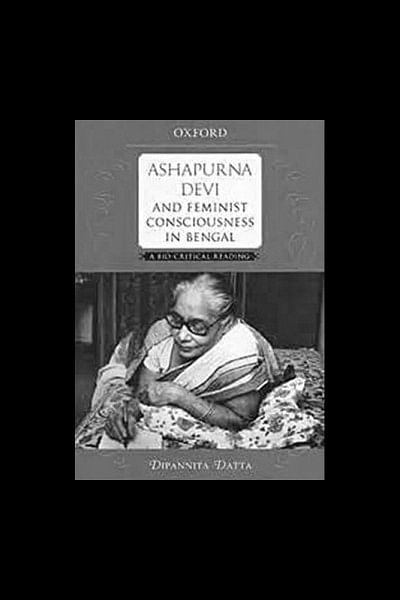Ashapurna Devi and the Feminist Consciousness in Bengal: A Biocritical Reading

OUP, ISBN: 978 0198 0999 9 4, 2015
The book engages with a critical discussion on feminist consciousness in India, perhaps in South Asia, as to the attributes of feminist challenge and success, and the facilitators of the process. Ashapurna Devi (1909-1995), author of more than 300 books, writing continuously for 70 years in Bengali, never attended school. She married at the age of fifteen, lived as a contented wife, mother and householder and wrote her fascinating novels and stories using whatever time she could find. During an interview with Partha Chatterjee, cited in the volume, Ashapurna Devi says her writing was encouraged by her husband and in-laws even while she attended, gladly, to the demands of a large household. In fact, according to Devi, "I wrote in between my domestic chores. I stopped my writing to find out what item would be cooked for the day….How can one finish saying everything? Life moves on without a pause. Times are also changing….So I continued writing about life, I cannot write about politics, offices, or the judiciary." No complaints from Devi - only reflections on how regional and domestic experience yielded the substance of her world-view.
Dipannita Datta, writer, translator and feminist scholar in her own right, probes the multiplicities in the life of Ashapurna Devi to show that traditional roles are not incompatible with women's creativity, and that Devi's novels, essays, letters and interviews illustrate a forceful sense of identity and selfhood. Articulate and thoughtful, Devi is quoted as saying, "Women need a special kind of self-sufficiency [and this] can come only with the consolidation of female power."Datta's 'bio-critical reading' gives an unusual structure to the book. It opens with three insightful chapters by Datta placing Ashapurna in the context of the societal changes unfolding in Bengal during her lifetime, including the reform movement and the national uprising, then Datta moves into the more intimate biography of a young woman's evolution in domestic space, and she finally elaborates upon Devi's unique ways of challenging hegemony. The opening sections take up about 140 pages and are followed by one section containing essays by Ashapurna Devi and letters written by and to her, and another section comprising of important interviews with Devi by eminent writers and critics. Altogether, the book combines impressive research and perspectives, and valuable archiving and analysis. For those enquiring into Ashapurna Devi, Indian literature, and issues of feminism in South Asia, this is a commendable source book and more.
Dipannita Datta's chapter "A Critical Overview" shows feminist awareness of the contradictions that Ashapurna Devi may exemplify. Devi may seem to be complicit with the 'silencing projects of imperialism and patriarchy' in accepting her domestic priorities in which her only complaint is that she could not receive formal education but learned to read Bengali from her book-loving mother. Through a phrase often referred to, "jadekhi, tai likhi" (I write what I see); Devi appears to favour the normative realism framing women's writing in the nineteenth and early twentieth century. Moreover, living in Calcutta under the sway of an imperial government, Devi seems to accept the principles of colonial modernity. Where, then, can we find the resisting writer, the woman whose novels and magazine serials were eagerly awaited by hundreds of readers; an author who was avidly pursued by beseeching publishers? Datta's comment is worth pondering over: "In trying to adopt an alternative strategy to be heard, Ashapurna Devi chose to explore her marginalised position and voice it in her writings. Her agenda was to create a space for women where their plight would be voiced and consequently be transmitted in order to be heard" (10).
How does this 'alternative strategy' work? Ashapurna Devi's magnum opus, the trilogy, Pratham Pratishruti (1964), Subarnalata (1967) and Bakul Katha (1974), captures the narratives of three generations of women. Beginning with feminine subjugations during the colonial period, Devi gives details of the antahpur culture that 'prevented women from becoming visible to the public', but speaks firmly through the woman's voice. If such writing is compared to women's fiction in English literature, about which Sandra Gilbert and Susan Gubar's Madwoman in the Atticis the classic feminist interpretation, one can see the contrast. In the British writing cited, the stereotypical images are of women as angels or as monsters; in Ashapurna Devi's strategy, the systems of patriarchy are exposed by using the collective voice of the women of the antahpur. Devi's domestic geography gestures towards the larger world with the next generation taking up the nationalist struggle. Feminism, in such a context, functions by linking the home and the world rather differently from the exploration of the sexual psychology of the British writers.
Yet Ashapurna Devi said she was not a social reformer but a mere witness to social change. The essays in the book are startling for their adherence to ground level reality while Devi dreams of women's emancipation. As Datta explains, "Ashapurna's essays delve deep into the tensions, conflict, ambiguity, and tragedy that had been naturalized in the historical process and show that women can get past 'the gruelling grind of their working world, and fulfill the demands of the changing times and public life'" (145). Far ahead of her times, Devi is talking about women's right to property, to equity and justice. Education and self- sufficiency are the keys to a dignified identity, and laws will not deliver what women need in social practice, she says. On may recall that Devi's Subarnalata articulates some of these issues, but it is left to Bakul of the new generation to project the possibilities of the future.
Another section contains the rare material of letters that are gentle, personal, and sometimes merely functional. The charm of old-time epistles lies in the unselfconscious revelation of the author in multiple roles. As a mother to Sushanta, she sends loving advice on his birthday, as a writer to a scholar-researcher in Prague she sends her books, as a contributor to a journal editor in Calcutta she enquires about the publication date of her work. Happily reproduced is a letter from a young Jhumpa Lahiri, aged 26, to 'Respected Ashapurna Devi' seeking permission to translate seven short stories and discuss them critically. (One may add a footnote that Lahiri expressed her admiration for Ashapurna Devi as recently as 2014).
Dipannita Datta has not only collected valuable material but also translated Ashapurna Devi's prose writing with marvellous felicity. While novels and stories by Devi are popularly available, the intellectual heritage that comes through essays and interviews is seldom passed into translation. The vision of this book is to present Ashapurna as a composite interpreter of the woman's condition in Bengal over a large span of time. In this, the writer and her times are inextricably linked. Datta's perspective is of a thoughtful feminist biographer who respects yet critiques a prodigious Bengali author. In the process she paves the way to an international readership for Ashapurna Devi and the likelihood of seeding cross cultural debates on feminism.
Malashri Lal is currently the Convener of the English Advisory Board of the Sahitya Akademi. She retired last year from her positions as the Dean of Colleges, Dean, Academic Activities & Projects and also Chairperson, Research Council at the University of Delhi.

 For all latest news, follow The Daily Star's Google News channel.
For all latest news, follow The Daily Star's Google News channel. 



Comments